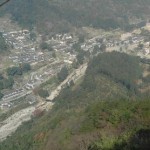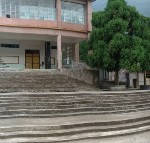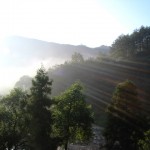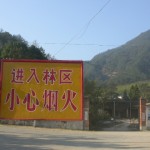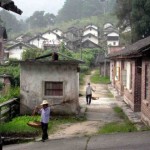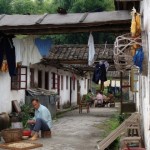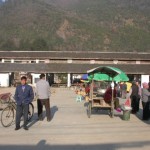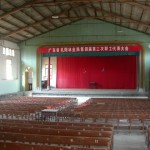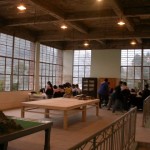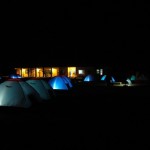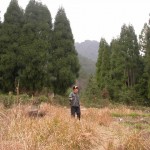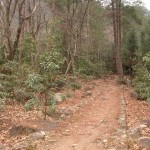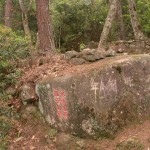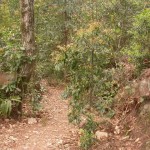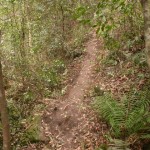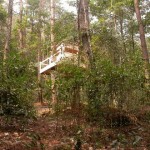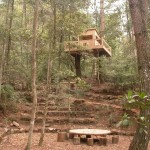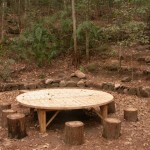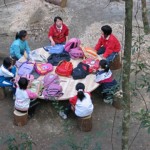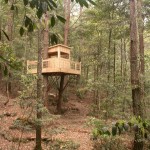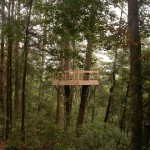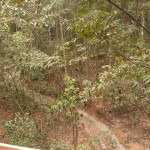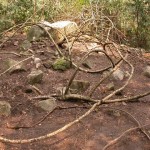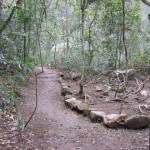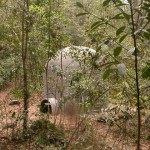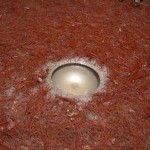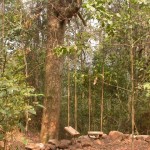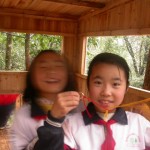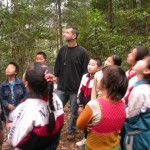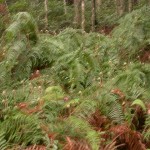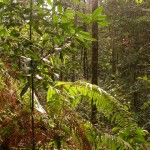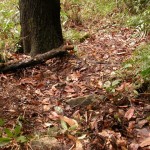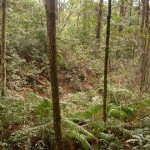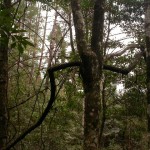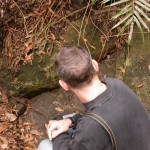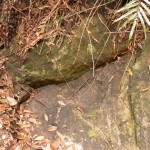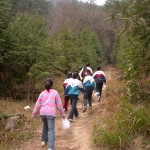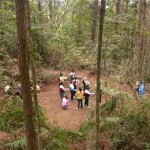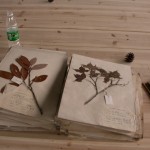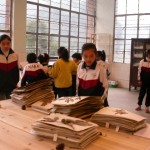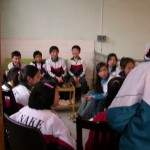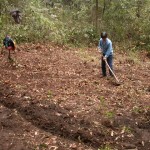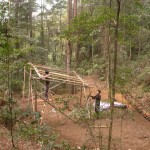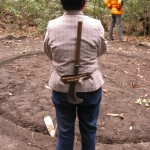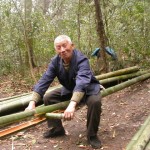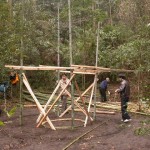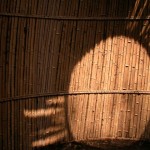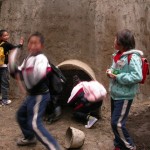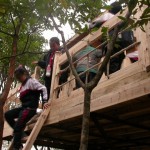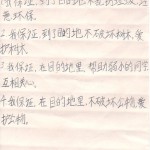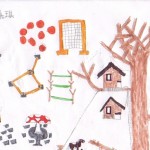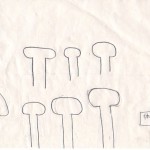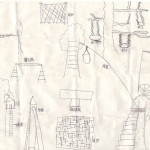Eco-art of play
Originally published by The Standard, Weekend: April 2-3, 2005
It takes only about 20 minutes to hike up the muddy slope to the edge of the Nanling National Forest but the blinding rain makes it feel a lot longer.Though we are all wearing colorful plastic ponchos, we are quickly soaked to the bone, and several members of our procession slip and fall along the way. The news we receive when we get to the treeline doesn't improve the general mood.``The children won't let us in,'' someone says, and this bit of information circulates through the waterlogged crowd in English, French, Putonghua and Cantonese, provoking mixed reactions of amusement and dismay.``Well, I guess it is their garden,'' says a Dutchman in a leather jacket trying to light a sodden cigarette to pass the time in the downpour.The rest of us huddle beneath umbrellas, hoping to get a glimpse of what we have come so far to see: A playground built by a prominent French artist and some Chinese schoolchildren in the middle of a forest.We are on Nanling Mountain on this rainy Sunday for the official opening of ``Back to Zhong Guo: Fools Move Mountains,'' an ambitious cultural project in northern Guangdong province.
Organized by Guangzhou's Vitamin Creative Space in partnership with Zhongheng Ecotourism Development and the French Consulate, this ``multi-layered dialogue'' will bring four French artists to the region to collaborate with the local community on assorted creative projects. The inaugural artist is Mathieu Briand, who settled into the town of Ruyang in early February to begin construction, in collaboration with local primary students, of an ``Eternal Garden,'' a playground in the woods that would be theirs and theirs alone.
Despite this being opening day, visitors are blocked at its entrance because one of the playground's founding rules reads: ``Adults are forbidden to go into the garden without the permission of the children in the management.'' This and other regulations had been put into writing at Ruyang Theater earlier in the afternoon, as some 600 locals and more than 100 visitors from Guangzhou and beyond crammed the wooden seats to watch the opening ceremony. After remarks in Chinese and French, Briand and a representative from Nanling National Forest Park signed a contract with the children, giving them complete stewardship of the playground and its immediate forest area for the next 50 years. Briand also picked 10 students' names out of a cardboard box - these children are the first 10 managers of the Eternal Garden. After six months, each student will pass on their duty (and official ring) to a friend, continuing a sense of ownership and responsibility through future generations. ``This is the most important part of the garden - it's yours,'' Briand said. ``It's about the idea of community. I told them, `if you choose to burn it down, it's your choice.''' Of course, Briand doesn't want them to burn it down. Quite the opposite: He hopes that the children's experience in the garden will inspire them to protect their home's fragile environment.
From the beginning, Fools Move Mountains was conceived as a way to raise awareness about the precious natural landscape of Nanling. Chen Xujun of Zhongheng Ecotourism Development says his agency set the project in motion in order to ``preserve the land and encourage a steady development.'' In contrast with feverish urbanization elsewhere in Guangdong, the Nanling Mountain area, which extends across the border into Hunan, is still remarkably pristine. The air is fresh, the water is clean and, despite being heavily logged for decades, the semi-deciduous broadleaf forest that covers the hillsides is reviving as an important center of plant and animal diversity. The woods also remain central to the region's economy, not for timber but as an ecotourism attraction. Zhongheng estimates that 100,000 tourists visit Nanling National Forest Park each year, mainly city-dwellers eager for a bucolic getaway. The profits are not yet high enough to fully support former logging towns such as Ruyang, so the challenge is to make ecotourism into a feasible industry before these towns succumb to less environmentally friendly development. Zhongheng is trying different strategies to promote ecological care in the district, from public service billboards to the renovation of an old village house into a tourist hostel. But what better way to honor nature than with landscape artworks?
Curator Hu Fang and Zhang Wei of Vitamin Creative Space jumped at the chance to stage an art event in Nanling's stunning topography. ``It was always a dream to realize an art project literally against the background of mountains and water,'' says Hu, explaining a concept from traditional Chinese painting - that the combined elements of mountains and water automatically create a landscape. They accepted Zhongheng's invitation to organize an art project. Vitamin Space decided to shake up traditional perspectives by bringing foreign artists to do residencies. As part of the Year of France in China, they linked up with French curator Evelyn Jouanno to select Briand, Shen Yuan, Sylvie Blocher and Marc Boucherot as the four participating artists. Even before the Year of France, a growing number of Chinese art institutions had been importing artists from abroad to do residencies and site-specific work. Hu explains the increase as a result of China's momentous changes.``I hope it's not just a trend, '' he says. ``It's a really exciting context for European artists to develop their ideas and find new possibilities.''
Briand agrees. ``To do this project in China is not the same as doing it anywhere else,'' he expounds, ``and it's actually not possible in Europe to produce this kind of thing any more.'' He describes a children's playground in France with a similar goal for kids to connect with nature, but scoffs at how tame the place is. ``Here, they might say it is dangerous, but the children can discover the world by themselves.'' So far, the children are doing fine with their project. When the garden's youthful ``management team'' finally lets the soaking grown-ups in, we gingerly step along the mountain trail toward a central clearing. After so much anticipation, the playground structures themselves could have been anti-climactic in their simplicity: Three wooden treehouses perch high on soaring trunks, semi-circular amphitheater seats are set into a hill crest, a round Chinese checker table with tree-stump seats, a large concrete igloo, some rope swings and a zip-line. But it is the arrangement of the components and their integration with the natural landscape that is moving. Cut wood reaches out from raw bark, a small plank bridge spans a gully, the three treehouse lookouts surround the central amphitheater: All are balanced, simultaneously graceful and rugged.Arty touches exist. A sculpture of tangled weeds is set in a pebbled frame on the ground and a loop of Chinese flute music emanates from the igloo, but these never overwhelm the playground's purpose: To inspire play.
After months of telling Briand what they wanted, and critiquing his sketches, cataloguing the leaves, and raking the dirt, the children finally have their garden and are making good use of it. Despite the persistent rain, they clamber up and down the tree-top platforms, crawl in and out of the igloo and jump back and forth across instant rivers made by the downpour. One child causes a brief scare by falling off a ladder, but is running around again in a matter of minutes. We grown-ups are mostly too big to fit through the igloo door, too heavy to even attempt the ladders, and can only enjoy the structures vicariously. Guangzhou-based artist Tracy Xie Cuiyi especially likes the igloo dome, as ``a good place for children to hide, think and dream.''
The entire playground is dreamlike, a magical landscape cut off from the adult world, complete with special entrance rules and a prestigious fellowship of caretakers.With any luck, Fools Move Mountains will continue to excite connections between the people of Nanling and their environment, up until the project's conclusion in November. Perhaps some of its installations might even prove eternal.
Xie Peishi, a Guangzhou fashion student in her early twenties, hopes that the garden will last forever.
“This isn't just a garden for children,” she says. “It is a sort of heaven.”


Shen Yuan: Nanling History 1957-2005
Shen Yuan: Nanling History 1957-2005
Shen Yuan was the second artist participating in the "Fools Move Mountains?" arts project. Her creation is related to the history of Nanling. She worked with 15 to 20 old, middle-aged and young women from Nanling Ruyang Forestry Bureau, trying to write a history about Nanling. The history of Nanling Ruyang area is short, but its growing process reflects the historic development of China after China's liberation. Histories are often written by men. To write the history by working with women enables the writer to look at the area from the aspects of politics, economy, culture and daily life in a way that is involves more personal feelings and emotions.
History of Nanling 1957-2005
Records of Discussion
Topic: Nanling Women Talk about the History of Nanling
Host: Shen Yuan
Location: Artist's Studio, 2nd Floor, Ruyang Theatre
Time/Date: 9:30am - 11:00am, 14 July, 2005
Working Team Members: Huang Xinghai, Yang Chao, Liu Fenghua, Director Liu,
Wang Lingju, Li Yinxia
Record Taker: Xu Liyan
Shen Yuan: Thank you very much for attending this Nanling Women Arts activity to talk about the history of Nanling. I am very honoured to have the opportunity to come to Nanling to carry out some arts work. When I heard that there was never a book about the history of Nanling, I started to think about inviting you, who represent women of three different ages (old, middle-aged and young), to talk about the history of Nanling in your eyes. May I ask you to please write down your memories on the paper with a brush? I will then compile them into a book.
Nanling Woman: Just after the 15th August in 1958, we came to Nanling. The main jobs here at that time were logistics, building houses and planting trees.
Nanling Woman: This organisation was originally established in Lechang in 1956. In 1957, the first group of 8 people arrived. One of them, we called him Grandpa Lai, died last year at the age of 91. Others are also very old now. These 8 people came to Ruyang to carry out surveys.
Our organisation is very big. In the past it was the Provincial Dept of Forestry under the direct jurisdiction of the country. Due to the need of work at that time, following the Party's instructions, I came to this primeval forest with my husband to chop trees for construction. I have been here for 48 years by now. 20 some people came in 1959 and I was one of them. We built triangle-shaped straw huts with white straws beside the river, and use huge aluminum pot to cook lunches. I cooked under that big tree in front of the door of the old canteen, and Aunt Wen cooked under another big tree. These trees all grow naturally. The diametre of the tree trunks was only 30cm then. Now it has grown to 70, 80cm.
There were a lot of monkeys at that time. When we came back from work, we would find food all having been stolen by the monkeys. They were very bold - ran down to the riverside from the mountains, opened the pot lid and took the food。
Later we thought of a way to drive these monkeys away. We shaved the head of a monkey we seized and painted the top in red before releasing it. The monkey was screaming while running away. Since then, they never dared to steal food from us. There were a lot of animals before. Monkeys, tigers were often seen.
Nanling Woman: Conditions were harsh in the past. Before the road was built, we had to travel on foot in the mountains. Grass grew very high. Some of it even had thorns. Our children were all very little, so we had to put them in baskets and carry them to walk a long way from the mountain valleys far away.
Nanling Woman: The provincial government was thinking to build a wood industry town of 100,000 people, but due to water problem (there was a lack of water), the plan failed to be implemented. The second group of immigrants arrived in 1959. In late 70s early 80s, the population started to shrink (they went to work in Shenzhen and Zhuhai). In 1993, the National Forest Park was planned to be built and in 1994 it opened to public. In 2003 after the Beijing-Zhuhai Express Way was finished, transport became much more convenient.
Nanling Woman: Ruyang experienced 3 ups and 3 downs. When we first started to work here, life was quite hard and primitive. Mountains need to be blown up in order to build roads, and this kind of work was very dangerous. 4000 people were recruited in 1959 (they were all young people). In order to be able to work in Ruyang, those who were under the minimum age lied about their ages. When the 18-kilometre-long road was being built, three young people died in the explosion. It was so unfortunate! So the efforts of the older generation should not be forgotten when enjoying the better life in Ruyang today.
Nanling Woman: There started to be a primary school in the second half of 1959. A nursery was also built at the same time. It is what we call kindergarten nowadays. But people all preferred to leave their children at their neighbour's. We took turns to look after children. There started to be a junior middle school in 1961 and a senior middle school in 1972.
Nanling Woman: But there is only a primary school now. Kids need to be boarders at junior middle schools in Ruyuan. They only come back once a month. The organisation has buses to send them to school and take them back. There were a lot of well-educated people here in the past --- many professors and doctors were critised to be "right-wing" during the Cultural Revolution and were banished here from cities. So the quality of education was quite high then. The principal of my primary school was from Tsinghua University but he only taught grade one and grade two here! The number of students is much smaller. We had over 50 students in one class, but due to the one child policy, most children are the only child in their families now. There are only 30 some students in each class in the primary school now, different from before.
Nanling Woman: I have been here since 1958 and I retired 10 years ago. Really glad to be with women of different ages here today. It has been 47 years since Ruyang started to be developed. I was only 19 when I came here and could be counted as a member of the first group of people to develop the area. My job was to cut down trees and build small railways. Hard work. At Mao Tse Dong's time, women was "half of the sky", so we were attached a lot of importance. Women could do all the work that man did. There was no road at that time, so the rice and other food for daily cooking had to be carried back on shoulders from Ruyuan and Daqiao. It was really tough!
We had to work for more than 10 hours a day, but we all were happy and hard-working. The ways in which trees were cut down were also the most primitive --- we used handsaws. As regard to cultural life, it was merely singing traditional operas in the auditorium downstairs, playing basketball and table tennis.
Shen Yuan: My mother played football when she was young. Women in Mao's time truly were half of the sky!
Nanling Woman: Yeah. Gardening, feeding pigs and growing vegetables were mainly women's work. Men were mainly responsible for chopping trees. But women could also chop trees. There were a lot of wood factories during the Cultural Revolution.
Nanling Woman: This place started to have a hospital in 1959. But it was called clinic. A lot of famous doctors came here after they had been critised to be "right-wing" and banished here. They were all highly qualified. There was even a surgery room here. But it does not exist anymore, because the doctors all went back to cities after their names being rectified. Now even pregnant women need to be sent to Ruyuan to give birth.
Shen Yuan: How did the name Ruyang come about?
Nanling: Ruyang Forestry Bureau was a tree-chopping team. It was under the direct jurisdiction of the provincial government, i.e., Guangdong Depart of Forestry before 1957. The name changed many times. From a tree-chopping team to Chopping Tree Wood Factory, then to to Wu Zhi Mountain Wood Factory. From Wuzhi Wood Factory to Forestry Administration Bureau, and then to Ruyang Forestry Bureau. There is a mountain here called Yang Mountain. Yang Mountain belongs to Guangdong and it is close to Ruyuan, so this place is called Ruyang.
Shen Yuan: How were the lumbers transported then?
Nanling Woman: The first a few Jie Fang trucks arrived in 1959. We used two-wheel push carts to send lumbers from the mountains to the road before the lumbers can be taken by trucks or small trains. But in 1975, there was a big flood and the small railway was crushed. Our team-6th Team, was divided into two groups. One group chopped trees on the mountain, and the other group planted trees on the mountain. We planted pine trees higher on the mountain and cedars lower on the mountain。
When the mountains needed to be blown up to build roads, I was the only woman who dared to explode the bomb with men. In 1959, when we were exploding the bomb near the school, an accident happened. A stone hit my head and the helmet I was wearing was broken into pieces. Fortunately a lot of famous doctors were here so the medical conditions were not bad. Nothing serious happened to me. I also built bridge high up in the sky. Again, I was the only woman who dared to take part in the work.
We made a living from chopping trees at that time. By 1982 and 1983, a hydropower station began to be built. In the 80s --- I do not remember which year it was --- my lower back was injured when the first hydropower station was being built. The work then was really dangerous.
Shen Yuan: Now I would like to give you paper and some brushes. You may write down your most unforgettable and meaningful memories about and experiences in Nanling on the paper and write down your names.
(Note: As per the request of speakers at the discussion, all speakers from Nanling are referred to as Nanling Women in the records)

Sylvie Blocher:Urban Story
French Artist Sylvie Blocher is the 3rd visiting artist of the Back to Zhong Guo: Fools Move Mountains. The complexity of the simple lifestyle in the Nanling Community inspired her creativity. Not only strongly attached to Nanling’s local situation, her work will also reveal the complicated relationship of Nanling and urban development. By videotaping interviews and collecting visual materials, she talks with people from a various range, listening to their own stories. In response to the fact that most of the local youth work in and immigrate to the cities, she also films in cities such as Guangzhou and Shenzhen, in order to associate the understanding towards the future of the Nanling Community to an expanded background.
Time and location of the Opening Day
Location A :
Conference Hall of the Guangzhou Academy of Fine-Arts, Guangzhou University City
Time: 15:00-17:00, September 28, 2005
(People involved in the work will be invited to come from Nanling to Guangzhou, to have a reverse interaction (instead of inviting people to Nanling, we invite them to come to the city) with artists and students, to give a feeling about the relationship between suburbs and urban development.)
Location B :
Ruyang Theatre, Nanling National Park, Guangdong
Time: 19:30-21:30 September 29, 2005

Marc Boucherot:Everything is Fine
French Artist Marc Boucherot is the 4th visiting artist of the Back to Zhong Guo: Fools Move Mountains. Marc’s project in Nanling is the mobile structure of the Cinema and “Kara OK” which transformed from a local three wheels moto,the Nanling community can use this structure to do party and have a pleasure time.
Time and location of the Opening Day
Location :
Ru Yang Market
Time:
6:30pm-10:30pm 12th Oct 2005
(Cinema & “Kara OK” Program)
7:00am 13th Oct 2005
Music
7:00pm-10:30pm 13th Oct 2005
(Cinema & “Kara OK” Program)
